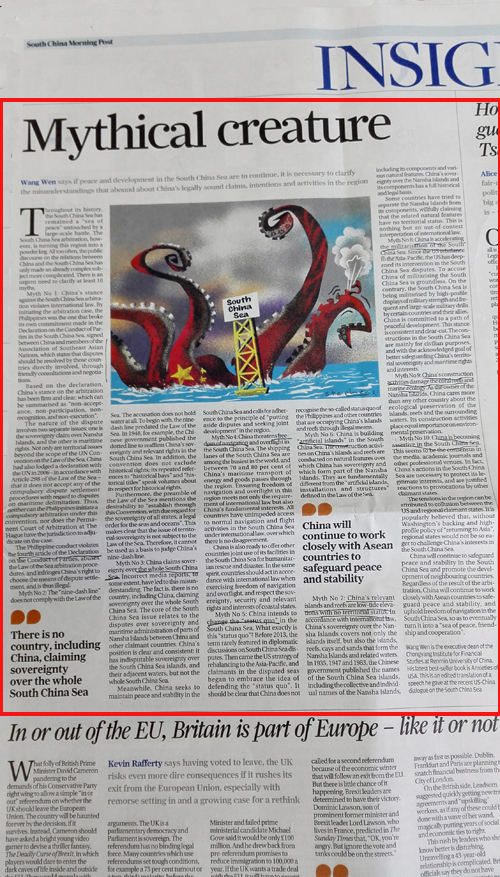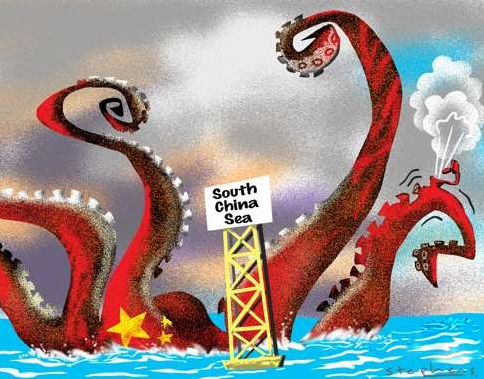发布时间:2016-07-08 作者: 王文
南海问题包含两个层面的争议:一是主权和领土争端,二是海洋权利争端,而《联合国海洋法公约》(以下简称《公约》)只对后者有裁决权。南海问题并不在国际仲裁庭的管辖范围之内。所谓中国违反国际法的说法,已然不攻自破。
作者王文系中国人民大学重阳金融研究院执行院长,陈晓晨、程阳对此文亦有贡献。中文版刊于7月8日参考消息整版,观察者网转载,英文版刊于7月10日南华早报。
南海仲裁案正在将这片历史上几乎从未发生过重大海战的平静海域,变成国际舆论中的“火药桶”。然而,人们对南海与中国的关系,并没有因为南海的国际聚焦而变得更清晰,相反,还有至少十大误解。7月5日,笔者参加了中美两国之间高规格的南海问题智库对话会,与两国30多位前政要、著名学者谈论这个问题,更感觉到澄清这十个错误认识的重要性。
1.中国不接受、不参与南海仲裁案,不承认、不执行仲裁结果是违反国际法?
面对2013年菲律宾单方面诉诸仲裁的做法,中国坚持“不接受、不参与、不承认、不执行”的“四不”立场,然而,外界有关中国此举违反国际法的声音从未停止。
南海问题包含两个层面的争议:一是主权和领土争端,二是海洋权利争端,而《联合国海洋法公约》(以下简称《公约》)只对后者有裁决权。众所周知,中国已于2006年根据《公约》作出排除性声明,将涉及海洋划界等方面的争议排除在《公约》规定的第三方争端解决程序之外。换句话说,南海问题并不在国际仲裁庭的管辖范围之内。所谓中国违反国际法的说法,已然不攻自破。
国际仲裁庭在明知其没有管辖权的情况下仍然受理菲律宾的诉求,将这两个层面的争议混合起来仲裁,无疑是一种危险的“越权”行为。面对不宜通过司法解决的争端,仲裁庭要维持其合法性,应该避免就南海问题进行“越权”裁决。
可以预见,南海问题不会因为仲裁庭的裁决而得到解决。相反,中国的“双轨”思路,即由直接当事国谈判协商解决争议、中国和东盟共同维护南海和平稳定,得到越来越多国家和地区组织的认可和支持。因此,宣布“本庭无法裁决此案,请有关各方尽最大努力协商解决”,这或许不失为仲裁庭可选的最理想裁决结果。

2.南海“九段线”违反《联合国海洋法公约》?
近代以来,中国人的海洋意识逐渐觉醒,南海是中国管辖面积最大的海域,中国在长期的历史过程中形成了对南沙群岛及其附近海域的主权和相关权利。南海“九段线”的划定与公布,正是中国人海权意识觉醒的现实体现。早在1948年,中国在公开发行的官方地图上就标绘了南海断续线,确认了中国对南海诸岛的主权和相关权益。《公约》多处提及“历史性海湾”“历史性所有权”等,显然是对历史性权利的尊重。
此外,中国是《公约》谈判的推动者,也是《公约》的践行者。中国对南海岛礁的主权历史远远早于《公约》签署的时代,符合《公约》中提到的“历史性所有权”,这种历史性权利又岂能因为菲律宾发起的仲裁而动摇?
3.中国对整个南海提出主权声索?
外界对南海问题的误解,很大程度上源于媒体的错误报道,其中包括“中国声索整个南海主权”等论调;同时在中国国内,也有媒体和民众认为整个南海都属于中国,这是事实性错误。这种误解和错误导致公众产生中国要把南海变成“中国内湖”的印象,从而产生中国试图规制南海范围内所有活动的错误认知。

事实上,中国“对南海诸岛及其附近海域拥有无可争辩的主权”并不等于“中国对整个南海提出主权声索”。
南海争议的核心是南沙岛礁领土主权争议和南海部分海域的划界争议。按照国际法的规定,国家对海洋的权利基于大陆,即海权基于陆权。要确定领海,先要建立领海基线,要划领海基线,先要定领海基点。领海基点必须是主权无争议的岛屿或大陆。整个南中国海海域的面积为350万平方公里,其中南海九条断续线之内,中国主张拥有主权、管辖权的海域面积为200多万平方公里。实际上,目前中国的南沙岛礁大部分被越南、菲律宾、马来西亚等国家非法侵占,为了维护南海的和平稳定,中国政府至今尚未公布南沙群岛领海基线。在争议得到解决之前,中国主张“搁置争议,共同开发”。
但毫无疑问的是,一方面,中国对南沙群岛及其附近海域拥有主权、管辖权的立场从未有所变化;另一方面,中国始终以南海断续线为主张拥有主权、管辖权的范围,从未将此主张扩大化。
4.中国威胁南海航行和飞越自由?
按照艾尔弗雷德·马汉的《海权论》,“谁控制了海洋,谁就控制了世界”,从历史上的西班牙、荷兰、英国到现在的美国,这一理论似乎放之四海而皆准。然而,若据此将中国海洋意识的觉醒及其在南海的维权行动当成是威胁海上航行和飞越自由,则显然是受到地缘利益和海洋秩序之争的蛊惑,也低估了中国遵守国际法的决心。
实际上,中国的海权实践远没有达到追求“海洋权力”的阶段,更不是追求霸权意义上的海洋权力。然而,中国无海洋不能立国,海运关系国家经济命脉,南海更是中国的海上生命线。现代中国作为一个开放的经济体,有70%-80%的国际贸易途经南海,如此说来,中国难道不应该是南海航行和飞越自由的最大受益者和自觉维护者吗?这片海域也是中国和周边国家共建“21世纪海上丝绸之路”的重要通道。因此,中国始终认可并支持国际航海与飞越自由的规则,并将承担责任和提供公共品,来维护保障这种自由。
中国当然也可以接受美国海军舰只和飞机在批准同意或合法通报的情况下无害通过,并且可以为美国舰船提供必要的协助。如果有人认为中国想“把美国排挤出亚洲”,“让南海变成中国内湖”,那一定是很严重的战略误判。
需要提醒注意的是,美国以“捍卫航行自由”等理由为其在南海的军事抵近侦察行为辩解,很容易让中国人民联想起19世纪欧洲侵略者的炮舰停留在长江口耀武扬威的行为。中国人民和政府始终对主权和领土完整问题抱有极强的敏感性,在时势危迫、旦夕千变的南海局势下,中国又岂能犹豫延缓,坐误光阴,使国家利益和国家安全屈从于外部压力,美国能理解中国人民思想最深处的自尊吗?
5.中国试图改变南海“现状”?
何谓南海“现状”?至少在2012年以前,南海问题只是中国和南海周边部分国家的一般性海洋权益摩擦。但从2012年起,南海问题突然跃升为亚洲乃至世界的热点问题,究其原因,南海问题的发展与美国“亚太再平衡”战略的实施不无关联,美国对南海问题关心之切、介入之深,都让中国感到“受宠若惊”。
中国一直努力奉行“和平崛起”的战乱,在崛起过程中不断借鉴学习西方崛起大国的经验教训,避免陷入大国挑战守成霸权国的“修昔底德陷阱”。因此,中国提出了“一带一路”倡议,主张构建“新型大国关系”,实际上是以新型理念探索出“大国政治悲剧”的破解之道,摆脱国强必霸的历史逻辑。
在南海问题上,中国坚持“搁置争议,共同开发”的原则,而且为了避免事态扩大,并未进行实际有效的开发。可以说,中国付出了巨大的诚意和牺牲。中国维护其合法海洋权利的种种努力和其间遇到的种种挑战,方才是南海的现状。
6.中国南沙岛礁是“人工岛屿”?
中国的岛礁建设依托于拥有主权且作为南沙群岛组成部分的有关自然地形,与《公约》中所称的“人工岛屿、设施和结构”有着本质区别。无论是在事实上还是法理上,南海相关岛礁本身即构成中国领土不可分割的组成部分,无需通过岛礁建设予以强化。
相反,某些国家罔顾基本事实,企图通过“低潮高地+扩建活动=人工岛屿”的偷换概念公事,将中方拥有主权的领土曲解为《公约》中的“人工岛屿”,是以此否定中国的主权。
7.中国的南沙岛礁为“低潮高地”,不具领土地位?
按照国际法,南沙地物,不论是岛屿、低潮高地、水下地物,均是构成南沙群岛不可分割的一部分。
在“南海仲裁案”中,菲律宾主张中国依据南海若干岩礁、低潮高地和水下地物提出的200海里甚至更多权利主张与《公约》不符,这实际上是试图通过否认岛礁地位在海域划界中的不可分割性、人为割裂“海域权利”与“海域划界”的密切关系等方式,规避海域划界争端例外方面的管辖权障碍。
菲律宾基于其对南沙群岛的“切割”处理,完全无视中国对南沙群岛整体所享有的领土主权与海洋权利,以图主张其仲裁诉求中所选南海部分岛礁仅仅是第121条第3款意义上的岩礁、低潮高地或水下地物,最多享有12海里领海的海洋权利,是歪曲滥用《公约》涉群岛条款,否认群岛在一般国际法、历史性权利等方面的依据。
8.中国寻求南海“军事化”?
自“亚太再平衡”战略实施以来,美国介入南海问题的核心切入点始终离不开指责中国在南海和南沙群岛进行所谓“军事化”部署和行动。然而,美国并非南海的利益攸关方,中国在南海的行动也并不危及美国的国家安全,后者却在背负着19万亿美元公共债务、国会连续削减军费预算的情况下,在南海花费巨资投入不必要的纠葛中,逐渐从幕后走向前台推动南海“军事化”,反映出中美两个大国之间缺乏战略互信的现实困境。
中国目前的海权实现能力尚未“溢出”其主权范围,在主权范围内的南沙岛礁建设,也是履行国际法赋予主权国家的权利,同时中国也有义务提升海洋服务能力,为过往的国际船舶和飞机提供补给、导航和救援,更好地维护航行自由,这是国际法框架下的国家义务。
9.中国南海岛礁建设破坏南海生态?
指责中国南海岛礁建设破坏南海生态,实际意图是将中国的维权行动置于破坏海洋生态的污名之下。中国古语有云,“欲加之罪,何患无辞”,这再次提醒我们,除了埋头苦干,在南海问题上中国还应该更主动地争取话语权。
中国周边海域珊瑚礁占全球珊瑚礁总面积的2.57%,居世界第八位。近年来,由于全球海水升温、海水酸化、渔业资源的过度捕捞以及海岸带开发等原因,出现了全球性珊瑚礁退化趋势,而为了做好南沙群岛的生态保护和利用工作,中国从1995年开始组织开展了大量科学考察和研究工作,对区域内的珊瑚礁生态系统特征有了清晰认识。
中国在南沙部分岛礁的扩建工程,不仅进行了科学评估与论证,而且执行了严格的环保标准。而科学评估与论证的数据资料直接来源于自1955年开始至今60余年对南沙岛礁生态系统特征、地质、地貌的综合考察和研究的积累,以便从中选择最佳建设方案。
2015年8月14日中午,经过4个小时的海上颠簸,三沙市生态环境保护专题调研组登上了鸭公岛
10.中国在南海变得具有攻击性?
随着南海局势的复杂化和尖锐化,有关“中国进攻性行为”和“中国进攻性填海作业”等表述开始频繁见于报端。在这类“话语霸权”之下,中国在南海的维权行为很容易被贴上“以大欺小”和“进攻性”的标签,将中国在南海的维权行为置于敌意的审视和质疑之下,其负面影响不容忽视。
事实上,近代以来西方国家曾对南海周边国家进行殖民统治,上个世纪日本军国主义的铁蹄曾践踏这里数年,美军也曾发动越南战争。历史告诉人们,中国是温和、克制的和平主义大国,但现在西方国家几乎在以“海禁”的标准衡量中国在南海的合法行动,造成南海周边国家同中国的对立,强化争议国对中国崛起的焦虑感,更加背离了通过对话协商解决南海问题的初衷。
维护主权和领土完整,并非等同于武力相向。当前,中国与南海周边各国面临的最重要课题就是实现持续快速发展,这需要和平稳定的环境,这是地区国家的“最大公约数”。我们仍然相信,通过南海各方的不懈努力,南海问题暂时的紧张不会影响这片海域及周边和平、稳定与发展的主旋律。我们仍然相信,通过中美两国之间各层级的对话,中美之间能够消除误解,减少误判,管控分歧,着眼长远,共同维护南海地区的和平稳定,为亚洲的和平发展发挥建设性作用,也为所有人的“太平洋世纪”贡献力量。
以下为英文版:

This article was published in the South China Morning Post on July 10.
Throughout its history, the South China Sea has remained a “sea of peace” untouched by a large-scale battle. The South China Sea arbitration, however, is turning this region into a powder keg. All too often, the public discourse on the relations between China and the South China Sea has only made an already complex subject more complicated. There is an urgent need to clarify at least 10 myths.

Myth No 1: China’s stance against the South China Sea arbitration violates international law. By initiating the arbitration case, the Philippines was the one that broke its own commitment made in the Declaration on the Conduct of Parties in the South China Sea, signed between China and members of the Association of Southeast Asian Nations, which states that disputes should be resolved by those countries directly involved, through friendly consultations and negotiations.
Based on the declaration, China’s stance on the arbitration has been firm and clear, which can be summarised as “non-acceptance, non-participation, non-recognition, and non-execution”.
The nature of the dispute involves two separate issues: one is the sovereignty claim over Nansha Islands, and the other is maritime rights. Not only are territorial issues beyond the scope of the UN Convention on the Law of the Sea, China had also lodged a declaration with the UN in 2006 – in accordance with Article 298 of the Law of the Sea – that it does not accept any of the compulsory dispute settlement procedures with regard to disputes on maritime delimitation. Thus, neither can the Philippines initiate a compulsory arbitration under this convention, nor does the Permanent Court of Arbitration at The Hague have the jurisdiction to adjudicate on the case.
The Philippine conduct violates the fourth article of the Declaration on the Conduct of Parties, abuses the Law of the Sea arbitration procedures, and infringes China’s right to choose the means of dispute settlement, and is thus illegal.
Myth No 2: The “nine-dash line” does not comply with the Law of the Sea.The accusation does not hold water at all. To begin with, the nine-dash line predated the Law of the Sea. In 1948, for example, the Chinese government published the dotted line to reaffirm China’s sovereignty and relevant rights in the South China Sea. In addition, the convention does not exclude historical rights; its repeated references to “historical bays” and “historical titles” speak volumes about its respect for historical rights.
Furthermore, the preamble of the Law of the Sea mentions the desirability to “establish through this Convention, with due regard for the sovereignty of all states, a legal order for the seas and oceans”. This makes clear that the issue of territorial sovereignty is not subject to the Law of the Sea. Therefore, it cannot be used as a basis to judge China’s nine-dash line.
Myth No 3: China claims sovereignty over the whole South China Sea. Incorrect media reports, to some extent, have led to this misunderstanding. The fact is, there is no country, including China, claiming sovereignty over the whole South China Sea. The core of the South China Sea issue relates to the disputes over sovereignty and maritime administration of parts of Nansha Islands between China and other claimant countries. China’s position is clear and consistent: it has indisputable sovereignty over the South China Sea islands, and their adjacent waters, but not the whole South China Sea.
Meanwhile, China seeks to maintain peace and stability in the South China Sea and calls for adherence to the principle of “putting aside disputes and seeking joint development” in the region.
Myth No 4: China threatens freedom of navigation and overflight in the South China Sea. The shipping lanes of the South China Sea are among the busiest in the world, and between 70 and 80 per cent of China’s maritime transport of energy and goods passes through the region. Ensuring freedom of navigation and overflight in this region meets not only the requirement of international law but also China’s fundamental interests. All countries have unimpeded access to normal navigation and flight activities in the South China Sea under international law, over which there is no disagreement.
China is also ready to offer other countries joint use of its facilities in the South China Sea for humanitarian rescue and disaster. In the same spirit, countries should act in accordance with international law when exercising freedom of navigation and overflight, and respect the sovereignty, security and relevant rights and interests of coastal states.
Myth No 5: China intends to change the “status quo” in the South China Sea. What exactly is this “status quo”? Before 2013, the term rarely featured in diplomatic discussions on South China Sea disputes. Then came the US strategy of rebalancing to the Asia-Pacific, and claimants in the disputed seas began to embrace the idea of defending the “status quo”. It should be clear that China does not recognise the so-called status quo of the Philippines and other countries that are occupying China’s islands and reefs through illegal means.
Myth No 6: China is building “artificial islands” in the South China Sea.The construction activities on China’s islands and reefs are conducted on natural features over which China has sovereignty and which form part of the Nansha Islands. They are fundamentally different from the “artificial islands, installations and structures” defined in the Law of the Sea.
Myth No 7: China’s relevant islands and reefs are low-tide elevations with no territorial status. In accordance with international law, China’s sovereignty over the Nansha Islands covers not only the islands itself, but also the islands, reefs, cays and sands that form the Nansha Islands and related waters. In 1935, 1947 and 1983, the Chinese government published the names of the South China Sea islands, including the collective and individual names of the Nansha Islands, including its components and various natural features. China’s sovereignty over the Nansha Islands and its components has a full historical and legal basis.
Some countries have tried to separate the Nansha Islands from its components, willfully claiming that the related natural features have no territorial status. This is nothing but an out-of-context interpretation of international law.
Myth No 8: China is accelerating the militarisation of the South China Sea.Since the US rebalance to the Asia-Pacific, the US has deepened its intervention in the South China Sea disputes. To accuse China of militarising the South China Sea is groundless. On the contrary, the South China Sea is being militarised by high-profile displays of military strength and frequent and large-scale military drills by certain countries and their allies. China is committed to a path of peaceful development. This stance is consistent and clear-cut. The constructions in the South China Sea are mainly for civilian purposes, and with the acknowledged goal of better safeguarding China’s territorial sovereignty and maritime rights and interests.
Myth No 9: China’s construction activities damage the coral reefs and marine ecology. As the owner of the Nansha Islands, China cares more than any other country about the ecological preservation of the islands, reefs and the surrounding waters. Its construction activities place equal importance on environmental preservation.
Myth No 10: China is becoming assertive in the South China Sea. This seems to be the consensus in the media, academic journals and other professional venues. In fact, China’s actions in the South China Sea are necessary to protect its legitimate interests, and are justified reactions to provocations by other claimant states. The tensions in the region can be attributed to collusion between the US and regional claimant states. It is popularly believed that, without Washington’s backing and high-profile policy of “returning to Asia”, regional states would not be so eager to challenge China’s interests in the South China Sea.
China will continue to safeguard peace and stability in the South China Sea and promote the development of neighbouring countries. Regardless of the result of the arbitration, China will continue to work closely with Asean countries to safeguard peace and stability, and uphold freedom of navigation in the South China Sea, so as to eventually turn it into a “sea of peace, friendship and cooperation”.
Wang Wen is the Executive Dean of the Chongyang Institute for Financial Studies at Renmin University of China. His latest best-seller book is Anxieties of USA. This is an edited translation of a speech he gave at the recent US-China dialogue on the South China Sea.
(欢迎关注人大重阳新浪微博:@人大重阳,微信公众号:rdcy2013)